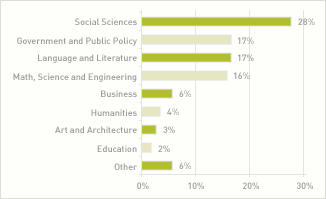How to become a certified teacher through Teach for America

Instead of getting a credential through college...
I have always wanted to be a teacher. Since I was younger I considered the impact I could make on the lives of children when they're most impressionable. It seemed like a wonderful way to make a difference.
As I got older I realized that it might not be something I would want to do for the rest of my life. Once it came down to the wire when I was applying to college I decided I would rather be a journalist instead and try my hand and good things that way.
However, I still had an interest in teaching. I was a little afraid of the workload and really had no interest in hanging around for another year to earn a teaching credential.
Then one day in a class a representative of Teach for America gave a presentation about the program and it sounded like the perfect thing. Two years after you graduate, get paid a normal beginning teacher's salary, and earn your credential along the way as you get paid... I asked what the catch was and apparently there isn't one.
It'll be hard work, but Teach for America is something I really want to do and I think it's one way to become a teacher that young people should consider.

Teach for America: The Mission
Today in our country, nine-year-olds growing up in low-income communities are already three grade levels behind their peers in high-income communities.
Half of them won't graduate from high school.
Those who do graduate will, on average, read and do math at the level of eighth graders in high-income communities.
This is our nation's most pressing problem.
But it doesn't have to be this way. While the problem is daunting, we see evidence every day in classrooms across the country that when students in low-income communities are given the educational opportunities they deserve, they excel.
It is this—the clear potential of students—that makes the disparities in educational outcomes so unconscionable and fuels our sense of urgency and responsibility to do everything we can to ensure educational opportunity for all.
Can I apply to Teach for America?
"We are searching for promising future leaders who have the leadership skills necessary to change the prospects of students growing up today and, ultimately, to effect fundamental changes in our society that enable this country to be a place of opportunity for all.
We recruit individuals of all majors and career interests, including those who majored in education and want to teach in low-income communities, as well as those with no prior experience in education or working with kids.
In 2006, almost 19,000 individuals applied to Teach For America."
There are only three basic requirements:
- Bachelor's degree
- 2.5 cumulative GPA
- U.S. citizenship or national/permanent resident status
The rep that came to my class said that basically anyone who makes the eligibility cut make it in; you're not competing with other applicants because Teach for America encourages entries.
Ethnic and socio-economic diversity in the 2006 corps
People of color 28.3% African-American 9.0% Latino/Hispanic 6.0% Asian-American 6.0% Native American 0.3% Multi-ethnic 5.0% Other (Non-white) 2.0% Pell Grant recipients 25%
Corps Members Academic Majors and Career Interests

The Perks of Teach for America
You get a teaching credential without having to pay for it.
In all Teach For America regions, corps members are eligible to obtain state-issued teaching certificates, licenses, or permits, which enable school districts to hire them.
In many cases, the ongoing coursework that corps members take as part of their region's alternative teaching program leads to full certification by the end of the two years. In other cases, corps members choose to take additional coursework beyond their two-year commitments to become fully certified. Most Teach For America regional offices have established partnerships with universities to facilitate corps members' work toward certification and in many regions corps members are also able to earn master's degrees within the two years.
You can experience life somewhere new.
Teach For America places corps members in 25 regions across the country. Urban sites include Atlanta, Baltimore, the Bay Area, Charlotte, Chicago, Connecticut, Houston, Los Angeles, Memphis, New Jersey, New York City, Philadelphia, Phoenix, St. Louis, and Washington, D.C. Rural sites include Eastern North Carolina, Hawaii, the Mississippi Delta (in Arkansas and Mississippi), New Mexico, the Rio Grande Valley, South Dakota, and South Louisiana. Three of our sites have both urban and rural placements: Greater New Orleans, the Las Vegas Valley, and Miami-Dade.
Those applicants who are invited to an interview rank each region as highly preferred, preferred, or less preferred, and they can indicate any special circumstances they would like us to consider, such as being placed with a spouse. In 2005, we were able to place 96 percent of accepted applicants in one of their highly preferred sites and 99 percent in one of their highly preferred or preferred sites.
You get paid and you don't have to pay interest on loans.
Corps members are paid directly by the school districts for which they work and generally receive the same salaries and health benefits as other beginning teachers. While beginning teacher salaries vary by district, most corps members find that they can live comfortably regardless of their region. Corps members teaching in urban sites typically have higher salaries, ranging from $28,000 to $44,000.
In an effort to ensure that qualified candidates of all economic situations are able to join our corps, we offer transitional grants and no-interest loans to help corps members make it to their first paychecks. Packages generally range from $1,000 to $6,000 based on a corps member's demonstrated need and the cost of living in the corps member's assigned region.
You get to teach!
Applicants invited to an interview indicate their preference for teaching different grade levels and subjects. Our ability to assign applicants to preferred grade levels and subjects is contingent upon applicants' academic backgrounds, district needs, and state and district certification requirements. Before assigning an accepted applicant to a region, we carefully evaluate the applicant's transcript information to determine eligibility to teach specific positions in each region. Because requirements vary from region to region, applicants may not be qualified to teach the same subjects and grade levels in all regions.
Depending on your previous coursework and the requirements in your region, you may be qualified to teach a variety of subjects.
How It Works
1. Apply
Step 1: Apply online.
Step 2: Check your status: phone interview notification
Step 3: Sign up for the phone interview
Step 4: Participate in a phone interview
Step 5: Check your status: final interview notification
Step 6: Submit assignment preference and transcript information
Step 7: Attend a final interview
Step 8: Check your final status: final admissions notification
Step 9: Learn about your assignemtn and make a decision
Step 10: Matriculate online
2. Train
All corps members are required to participate in a five-week training institute before they begin teaching. The institute prepares corps members to be highly effective teachers while measurably increasing the academic performance of children in their summer school classrooms. In the mornings and early afternoons, corps members teach in a district summer school program under the close supervision of veteran educators. These include teachers from the hosting school district and Teach For America instructional staff. In the late afternoons and evenings, corps members participate in interactive courses and clinics to build knowledge, deepen skills, and apply learning to upcoming teaching. Although there is little formal programming on weekends, corps members usually find it important to do lesson planning and preparation on Saturdays and Sundays, or to study for and take any required tests for their fall placements.
Attending the institute in full is a requirement of joining Teach For America, and applicants must attend the institute to which their region is assigned.
Institutes are in Atlanta, Houston, Philadelphia, Los Angeles, and New York City.
3. Start teaching!
Observation and Feedback:
Teach For America program directors go through four observation and feedback cycles with each corps member per year. Each cycle involves reviewing student achievement data, the program director conducting detailed observations, and the program director and corps member jointly problem solving to identify the root causes of any current gaps in student achievement to determine additional steps the corps member might take to improve student achievement.
Tools:
Each region provides a toolkit to help corps members created a data-driven, student achievement focused classroom from day one. The toolkit includes long-term instructional plans tailored to state standards and the district's curriculum for each grade and subject area, diagnostic tests and ongoing assessments, and student achievement tracking tools.
Learning Teams:
Corps members get together in small groups customized by grade and subject area with Teach For America instructors to discuss ongoing struggles, share best practices, and engage in collective professional development.
Teaching as Leadership Framework
The Teaching As Leadership framework articulates the key strategies used by highly effective corps members and forms the basis for Teach For America's definition of teacher effectiveness.
The framework identifies six categories of actions that enable teachers to help their students attain significant academic achievement:
Set an ambitious vision of students' academic success
Teachers who lead students in low-income areas to two, three, or four years' worth of academic progress in a single year are those teachers who, before the year even begins, set an ambitious, measurable goal for where they want their students to be academically at the end of the year. These big goals can energize both a teacher and students with the motivation and focus they will need to carry them past the inevitable internal and external obstacles on the path to academic achievement.
Invest students and their families in working hard toward the vision
Highly successful leaders on the frontlines of the achievement gap also recognize that they must break the entrenched cycle of self-fulfilling low expectations that often characterizes their students' sense of self-worth and perspective on school. These teachers tackle and change students' learned belief that intelligence is a "fixed" characteristic and convince their students that if they work hard enough, they will "get smart." They doggedly establish and maintain their high expectations for students in every aspect of their interactions and ensure students feel successful by meeting them where they are academically.
Plan purposefully to meet ambitious academic goals
To succeed in the difficult contexts where the achievement gap festers, teachers have to be strong "backwards planners," starting every endeavor, from individual lessons to grand, year-long calendars, with the key questions, "Where are my students now versus where I want them to be", and "What is the best possible use of time to move them forward?" The highly successful teachers we see infuse their goal-driven efficiency into every aspect of instruction and classroom management.
Execute those plans thoroughly and effectively
Strong classroom leaders are effective executives, making good judgments about when to follow through on their plans and when to adjust them in light of incoming data. They offer their students consistent, caring, demanding leadership, and constantly seek to maximize the time students have to work hard toward their goals.
Work relentlessly to meet high academic goals for students
In the challenging contexts of low-income communities where schools with the least capacity are serving children with the greatest need, putting children on a level playing field requires leaders who cast off the conventional parameters of their role as "teacher" and commit to doing whatever it takes to lead their students to academic success. Our successful corps members refuse to allow the inevitable challenges that they face to become roadblocks. Instead, they see those challenges as obstacles that they will navigate on their path to ambitious goals.
Continuously reflect and improve on leadership and effectiveness
Strong leaders are their own toughest critics, constantly seeking ways to improve their skills. Our most successful corps members use data-driven self-analysis to ensure that they are maximizing the learning opportunities in their classrooms, thereby increasing their impact in the fight against the achievement gap.
Teach for America Links
- About Us
More about Teach for America in general - Admissions
More about being admitted into the program - The Corps Experience
Why graduates joined Teach for America - Teach for America - Home
The homepage for Teach for America








